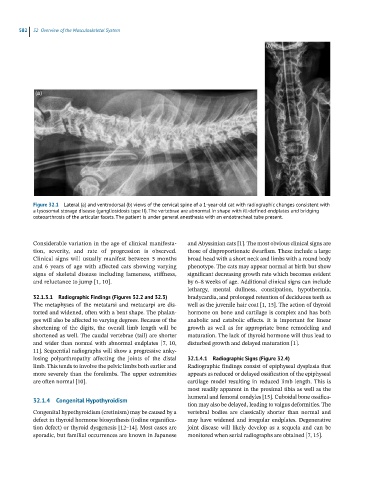Page 568 - Feline diagnostic imaging
P. 568
582 32 Overview of the Musculoskeletal System
Figure 32.1 Lateral (a) and ventrodorsal (b) views of the cervical spine of a 1-year-old cat with radiographic changes consistent with
a lysosomal storage disease (gangliosidosis type II). The vertebrae are abnormal in shape with ill-defined endplates and bridging
osteoarthrosis of the articular facets. The patient is under general anesthesia with an endotracheal tube present.
Considerable variation in the age of clinical manifesta- and Abyssinian cats [1]. The most obvious clinical signs are
tion, severity, and rate of progression is observed. those of disproportionate dwarfism. These include a large
Clinical signs will usually manifest between 5 months broad head with a short neck and limbs with a round body
and 6 years of age with affected cats showing varying phenotype. The cats may appear normal at birth but show
signs of skeletal disease including lameness, stiffness, significant decreasing growth rate which becomes evident
and reluctance to jump [1, 10]. by 6–8 weeks of age. Additional clinical signs can include
lethargy, mental dullness, constipation, hypothermia,
32.1.3.1 Radiographic Findings (Figures 32.2 and 32.3) bradycardia, and prolonged retention of deciduous teeth as
The metaphyses of the metatarsi and metacarpi are dis- well as the juvenile hair coat [1, 15]. The action of thyroid
torted and widened, often with a bent shape. The phalan- hormone on bone and cartilage is complex and has both
ges will also be affected to varying degrees. Because of the anabolic and catabolic effects. It is important for linear
shortening of the digits, the overall limb length will be growth as well as for appropriate bone remodeling and
shortened as well. The caudal vertebrae (tail) are shorter maturation. The lack of thyroid hormone will thus lead to
and wider than normal with abnormal endplates [7, 10, disturbed growth and delayed maturation [1].
11]. Sequential radiographs will show a progressive anky-
losing polyarthropathy affecting the joints of the distal 32.1.4.1 Radiographic Signs (Figure 32.4)
limb. This tends to involve the pelvic limbs both earlier and Radiographic findings consist of epiphyseal dysplasia that
more severely than the forelimbs. The upper extremities appears as reduced or delayed ossification of the epiphyseal
are often normal [10]. cartilage model resulting in reduced limb length. This is
most readily apparent in the proximal tibia as well as the
humeral and femoral condyles [15]. Cuboidal bone ossifica-
32.1.4 Congenital Hypothyroidism
tion may also be delayed, leading to valgus deformities. The
Congenital hypothyroidism (cretinism) may be caused by a vertebral bodies are classically shorter than normal and
defect in thyroid hormone biosynthesis (iodine organifica- may have widened and irregular endplates. Degenerative
tion defect) or thyroid dysgenesis [12–14]. Most cases are joint disease will likely develop as a sequela and can be
sporadic, but familial occurrences are known in Japanese monitored when serial radiographs are obtained [7, 15].

